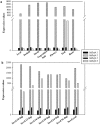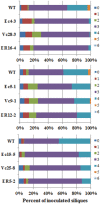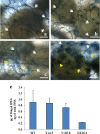Subcellular targeting of an evolutionarily conserved plant defensin MtDef4.2 determines the outcome of plant-pathogen interaction in transgenic Arabidopsis
- PMID: 22776629
- PMCID: PMC6638660
- DOI: 10.1111/j.1364-3703.2012.00813.x
Subcellular targeting of an evolutionarily conserved plant defensin MtDef4.2 determines the outcome of plant-pathogen interaction in transgenic Arabidopsis
Abstract
The Medicago truncatula gene encoding an evolutionarily conserved antifungal defensin MtDef4.2 was cloned and characterized. In silico expression analysis indicated that MtDef4.2 is expressed in many tissues during the normal growth and development of M. truncatula. MtDef4.2 exhibits potent broad-spectrum antifungal activity against various Fusarium spp. Transgenic Arabidopsis thaliana lines in which MtDef4.2 was targeted to three different subcellular compartments were generated. These lines were tested for resistance to the obligate biotrophic oomycete Hyaloperonospora arabidopsidis Noco2 and the hemibiotrophic fungal pathogen Fusarium graminearum PH-1. MtDef4.2 directed to the extracellular space, but not to the vacuole or retained in the endoplasmic reticulum, conferred robust resistance to H. arabidopsidis. Siliques of transgenic Arabidopsis lines expressing either extracellularly or intracellularly targeted MtDef4.2 displayed low levels of resistance to F. graminearum, but accumulated substantially reduced levels of the mycotoxin deoxynivalenol. The data presented here suggest that extracellularly targeted MtDef4.2 is sufficient to provide strong resistance to the biotrophic oomycete, consistent with the extracellular lifestyle of this pathogen. However, the co-expression of extracellular and intracellular MtDef4.2 is probably required to achieve strong resistance to the hemibiotrophic pathogen F. graminearum which grows extracellularly and intracellularly.
© 2012 THE AUTHORS. MOLECULAR PLANT PATHOLOGY © 2012 BSPP AND BLACKWELL PUBLISHING LTD.
Figures











Similar articles
-
Expression of apoplast-targeted plant defensin MtDef4.2 confers resistance to leaf rust pathogen Puccinia triticina but does not affect mycorrhizal symbiosis in transgenic wheat.Transgenic Res. 2017 Feb;26(1):37-49. doi: 10.1007/s11248-016-9978-9. Epub 2016 Aug 31. Transgenic Res. 2017. PMID: 27582300 Free PMC article.
-
Structural and functional studies of a phosphatidic acid-binding antifungal plant defensin MtDef4: identification of an RGFRRR motif governing fungal cell entry.PLoS One. 2013 Dec 4;8(12):e82485. doi: 10.1371/journal.pone.0082485. eCollection 2013. PLoS One. 2013. PMID: 24324798 Free PMC article.
-
Antifungal mechanisms of a plant defensin MtDef4 are not conserved between the ascomycete fungi Neurospora crassa and Fusarium graminearum.Mol Microbiol. 2016 May;100(3):542-59. doi: 10.1111/mmi.13333. Epub 2016 Apr 1. Mol Microbiol. 2016. PMID: 26801962
-
Antifungal plant defensins: mechanisms of action and production.Molecules. 2014 Aug 14;19(8):12280-303. doi: 10.3390/molecules190812280. Molecules. 2014. PMID: 25153857 Free PMC article. Review.
-
The mode of antifungal action of plant, insect and human defensins.Cell Mol Life Sci. 2008 Jul;65(13):2069-79. doi: 10.1007/s00018-008-8035-0. Cell Mol Life Sci. 2008. PMID: 18360739 Free PMC article. Review.
Cited by
-
Research Progress and Prospect of Alfalfa Resistance to Pathogens and Pests.Plants (Basel). 2022 Aug 1;11(15):2008. doi: 10.3390/plants11152008. Plants (Basel). 2022. PMID: 35956485 Free PMC article. Review.
-
Insect antimicrobial peptides and their applications.Appl Microbiol Biotechnol. 2014 Jul;98(13):5807-22. doi: 10.1007/s00253-014-5792-6. Epub 2014 May 9. Appl Microbiol Biotechnol. 2014. PMID: 24811407 Free PMC article. Review.
-
Field resistance to Fusarium oxysporum and Verticillium dahliae in transgenic cotton expressing the plant defensin NaD1.J Exp Bot. 2014 Apr;65(6):1541-50. doi: 10.1093/jxb/eru021. Epub 2014 Feb 6. J Exp Bot. 2014. PMID: 24502957 Free PMC article.
-
Peanuts that keep aflatoxin at bay: a threshold that matters.Plant Biotechnol J. 2018 May;16(5):1024-1033. doi: 10.1111/pbi.12846. Epub 2017 Oct 17. Plant Biotechnol J. 2018. PMID: 28973784 Free PMC article.
-
Mutations in the Arabidopsis homoserine kinase gene DMR1 confer enhanced resistance to Fusarium culmorum and F. graminearum.BMC Plant Biol. 2014 Nov 29;14:317. doi: 10.1186/s12870-014-0317-0. BMC Plant Biol. 2014. PMID: 25432266 Free PMC article.
References
-
- Allen, A. , Islamovic, E. , Kaur, J. , Gold, S. , Shah, D. and Smith, T.J. (2011) Transgenic maize plants expressing the Totivirus antifungal protein, KP4, are highly resistant to corn smut. Plant Biotechnol. J. 9, 857–864. - PubMed
-
- Benedito, V.A. , Torres‐Jerez, I. , Murray, J.D. , Andriankaja, A. , Allen, S. , Kakar, K. , Wandrey, M. , Verdier, J. , Zuber, H. , Ott, T. , Moreau, S. , Niebel, A. , Frickey, T. , Weiller, G. , He, J. , Dai, X. , Zhao, P.X. , Tang, Y. and Udvardi, M.K. (2008) A gene expression atlas of the model legume Medicago truncatula . Plant J. 55, 504–513. - PubMed
-
- Boutigny, A.L. , Barreau, C. , Atanasova‐Penichon, V. , Verdal‐Bonnin, M.N. , Pinson‐Gadais, L. and Richard‐Forget, F. (2009) Ferulic acid, an efficient inhibitor of type B trichothecene biosynthesis and Tri gene expression in Fusarium liquid cultures. Mycol. Res. 113, 746–753. - PubMed
Publication types
MeSH terms
Substances
LinkOut - more resources
Full Text Sources
Miscellaneous

